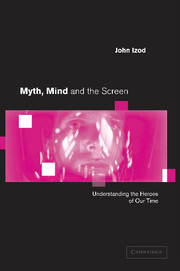Book contents
- Frontmatter
- Contents
- Acknowledgments
- Introduction
- 1 Jungian theory, textual analysis and audience play
- 2 Archetypal images: signification and the psyche
- 3 Archetypal images: symbols and the cultural unconscious
- 4 The Piano, the animus and colonial experience
- 5 The pop star as icon
- 6 The quest of a female hero: The Silence of the Lambs
- 7 Television sport and the sacrificial hero
- 8 The polycentred self: The Passion of Darkly Noon
- 9 Haunted: searching for the whole self
- 10 Transforming the final ghost: the god within
- Conclusion
- Filmography
- Glossary of Jungian and related terms
- References
- Index
3 - Archetypal images: symbols and the cultural unconscious
Published online by Cambridge University Press: 22 September 2009
- Frontmatter
- Contents
- Acknowledgments
- Introduction
- 1 Jungian theory, textual analysis and audience play
- 2 Archetypal images: signification and the psyche
- 3 Archetypal images: symbols and the cultural unconscious
- 4 The Piano, the animus and colonial experience
- 5 The pop star as icon
- 6 The quest of a female hero: The Silence of the Lambs
- 7 Television sport and the sacrificial hero
- 8 The polycentred self: The Passion of Darkly Noon
- 9 Haunted: searching for the whole self
- 10 Transforming the final ghost: the god within
- Conclusion
- Filmography
- Glossary of Jungian and related terms
- References
- Index
Summary
Jeremy Carrette has made a meticulous examination of the ways in which Jung and his followers have used the term ‘archetype’. He shows how an idea which Jung introduced as a means of bringing order to the description of subjective experience has become reified into supposed objectivity. What was originally a convenient hypothesis with which to explain what Jung called the bewildering conglomeration of psychic realities shifted its meaning constantly. It did so in the first instance under the pressure of his own constantly evolving thoughts and the discursive imprecision with which he used the term. After his death, unfortunate developments occurred in that what he intended as a provisional working implement to aid understanding of the unconscious became in the usage of many Jungians something close to a religious dogma itself (Carrette 1994: 168–71, 185–6). The thrust of Carrette's argument is that it is more productive to work with the images themselves than with a theoretical construct that has been reified on dogmatic grounds.
Notwithstanding the fact that if the term is to have any value, archetypal images must have a universalising potential, they must also be shaped and coloured by the culture of their time if they are to communicate through its language and signifying systems. Therefore, while the archetypes themselves may be presumed to remain constant, archetypal images alter in the sense that they take new shapes across the generations and between cultures, and we have already seen some partial evidence of this in the case of the Western.
- Type
- Chapter
- Information
- Myth, Mind and the ScreenUnderstanding the Heroes of our Time, pp. 47 - 56Publisher: Cambridge University PressPrint publication year: 2001



